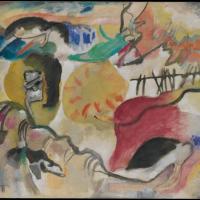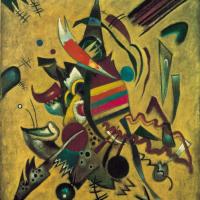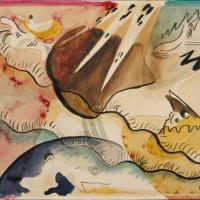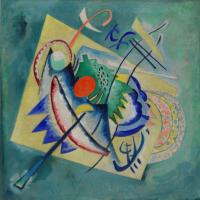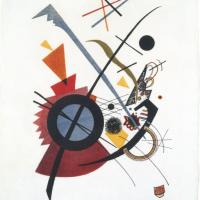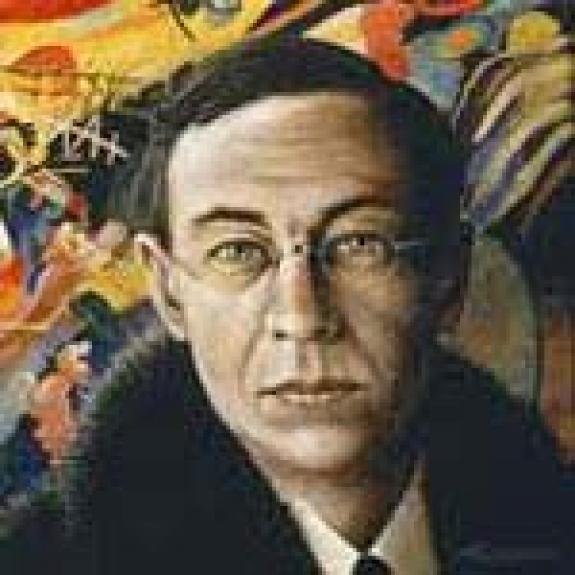Wassily Kandinsky
Composition IV
$80.00
Composition VIII (No. 8)
$450.00
Improvisation 27
$450.00
Points
$450.00
Rain Landscape
$450.00
Red Oval
$510.00
Violett
$450.00
Wassily Kandinsky
Wassily Kandinsky (1866-1944)
Wassily Wassilyevich Kandinsky (16 December or 4 December 1866 – 13 December 1944) was a Russian painter and art theorist.
Kandinsky is generally credited as the pioneer of abstract art. Born in Moscow, Kandinsky spent his childhood in Odessa, where he graduated at Grekov Odessa Art school. He enrolled at the University of Moscow, studying law and economics. Successful in his profession—he was offered a professorship (chair of Roman Law) at the University of Dorpat—Kandinsky began painting studies (life-drawing, sketching and anatomy) at the age of 30.
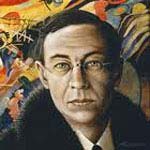
In 1896, Kandinsky settled in Munich, studying first at Anton Ažbe's private school and then at the Academy of Fine Arts. He returned to Moscow in 1914, after the outbreak of World War I. Following the Russian Revolution, Kandinsky "became an insider in the cultural administration of Anatoly Lunacharsky" and helped establish the Museum of the Culture of Painting. However, by then "his spiritual outlook... was foreign to the argumentative materialism of Soviet society", and opportunities beckoned in Germany, to which he returned in 1920. There he taught at the Bauhaus school of art and architecture from 1922 until the Nazis closed it in 1933. He then moved to France, where he lived for the rest of his life, becoming a French citizen in 1939 and producing some of his most prominent art. He died in Neuilly-sur-Seine in 1944.
Kandinsky's creation of abstract work followed a long period of development and maturation of intense thought based on his artistic experiences. He called this devotion to inner beauty, fervor of spirit, and spiritual desire inner necessity; it was a central aspect of his art.
In 2012, Christie's auctioned Kandinsky's Studie für Improvisation 8 (Study for Improvisation 8), a 1909 view of a man wielding a broadsword in a rainbow-hued village, for $23 million. The painting had been on loan to the Kunstmuseum Winterthur, Switzerland, since 1960 and was sold to a European collector by the Volkart Foundation, the charitable arm of the Swiss commodities trading firm Volkart Brothers. Before this sale, the artist's last record was set in 1990 when Sotheby's sold his Fugue (1914) for $20.9 million. On November 16, 2016 Christie's auctioned Kandinsky's Rigide et courbé (rigid and bent), a large 1935 abstract painting, for $23.3 million, a new record for Kandinsky. Solomon R. Guggenheim originally purchased the painting directly from the artist in 1936, but it was not exhibited after 1949, and was then sold at auction to a private collector in 1964 by the Solomon R. Guggenheim Museum.
The 1990 play Six Degrees of Separation refers to a "double-sided Kandinsky" painting. No such painting is known to exist; in the 1993 film version of the play, the double-sided painting is portrayed as having Kandinsky's 1913 painting Black Lines on one side and his 1926 painting Several Circles on the other side.
The 1999 film Double Jeopardy makes numerous references to Kandinsky, and a piece of his, Sketch, figures prominently in the plot-line. The protagonist, Elizabeth Parsons (Ashley Judd), utilises the registry entry for the work to track down her husband under his new alias. Two variations of the almanac cover of Blue Rider are also featured in the film.
In 2014, Google commemorated Kandinsky's 148th birthday by featuring a Google Doodle based on his abstract paintings.
A picture-book biography entitled The Noisy Paint Box: The Colors and Sounds of Kandinsky's Abstract Art was published in 2014. Its illustrations by Mary GrandPre earned it a 2015 Caldecott Honor.
His grandson was musicology professor and writer Aleksey Ivanovich Kandinsky (1918–2000), whose career was both focused on and centred in Russia.
The Solomon R. Guggenheim Museum held a major retrospective of Kandinsky's work from 2009-2010, called Kandinsky. In 2017, a selection of Kandinsky's work was on view at the Guggenheim.


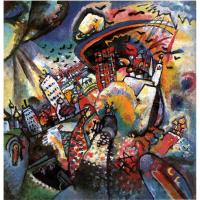
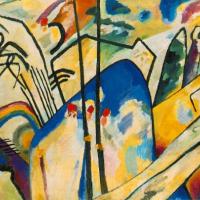
-200x200.jpg)
